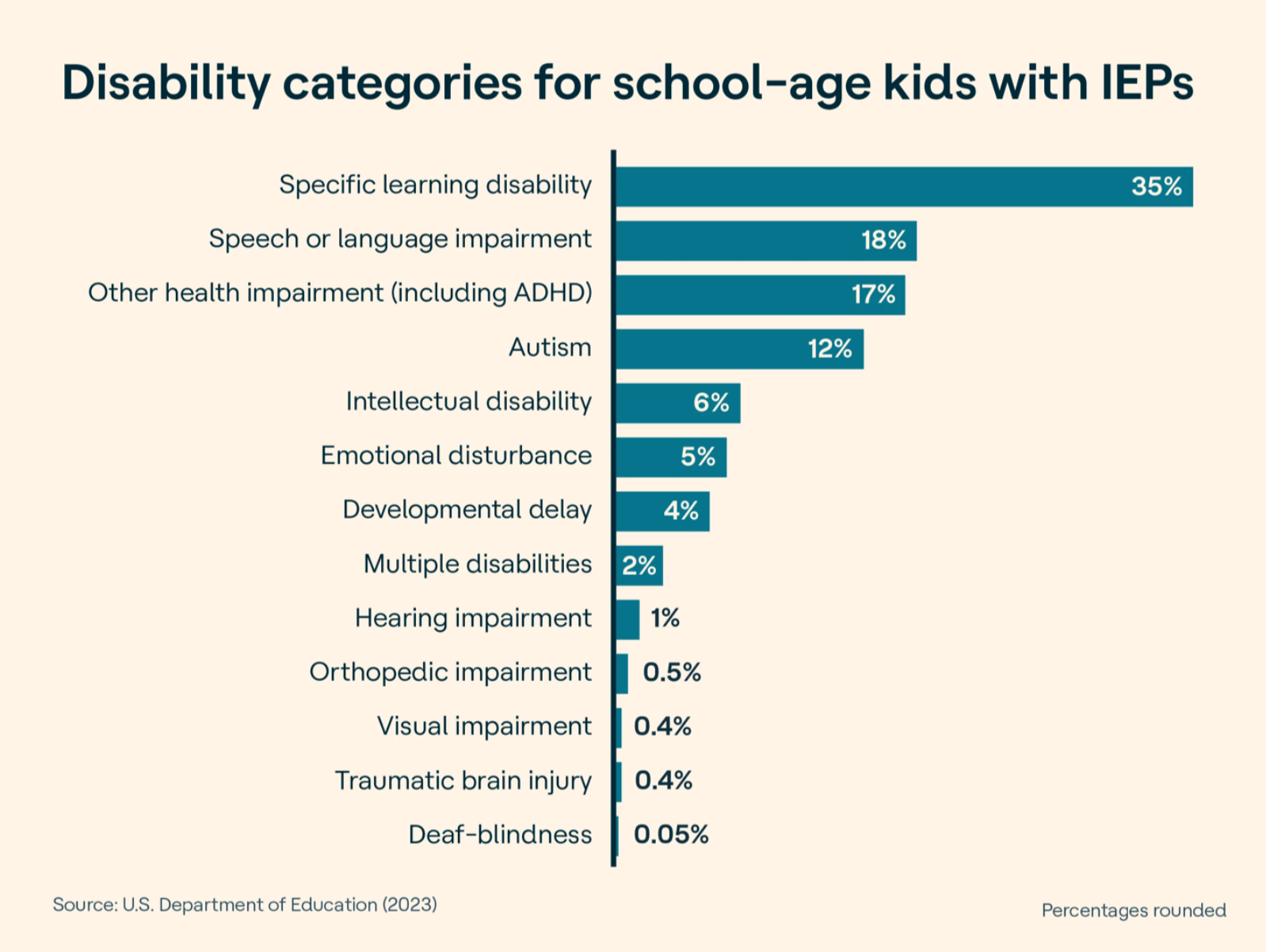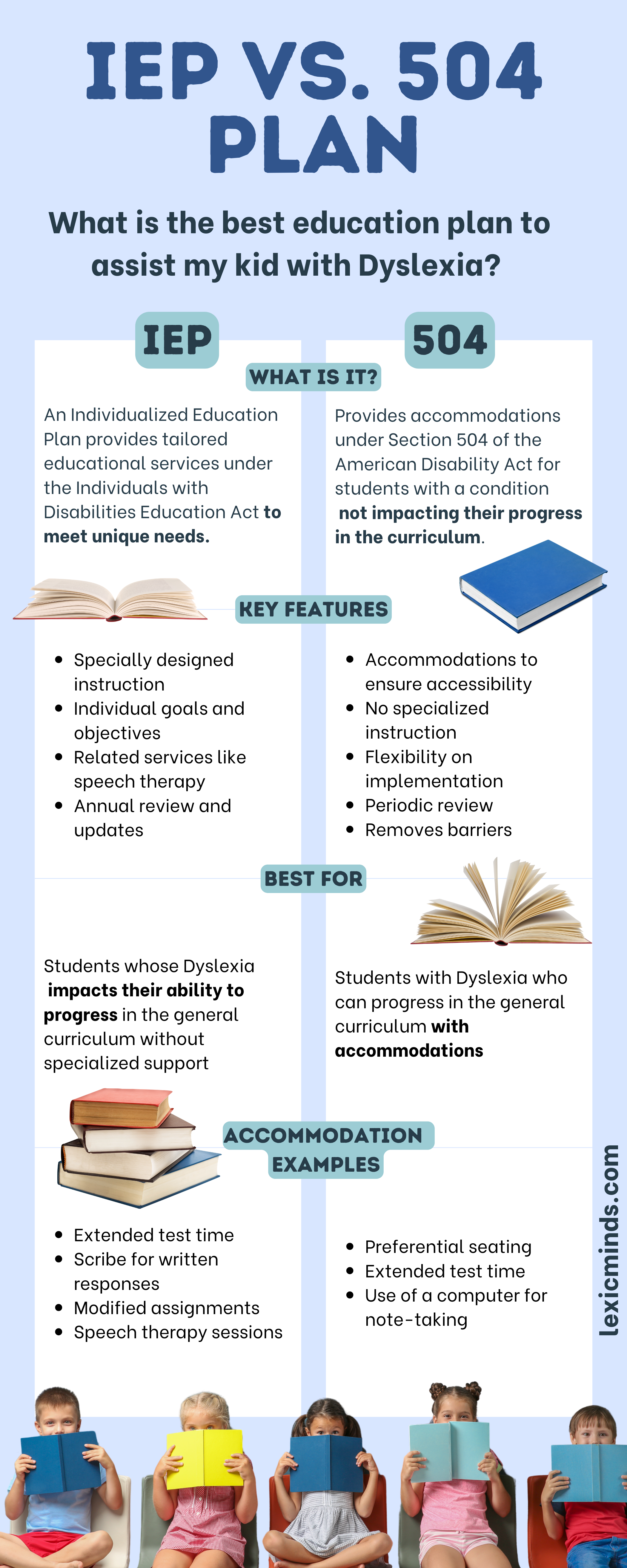When your child is diagnosed, one next step is figuring out how to set them up for success in school: IEP vs. 504 plan for Dyslexia? These are the two main ways public schools provide support to students with Dyslexia.
These are similar, but not the same, so it’s important to understand each option, and how to identify which is best for your child.Â
IDEA and ADA: Law 101Â
When it comes to supporting students with disabilities, including dyslexia, schools are governed by two main laws the Individuals with Disabilities Act (IDEA) and Section 504 of the Americans with Disabilities Act (ADA).Â
- IDEA is an education law that requires schools to provide a Free Appropriate Public Education to students with disabilities (more on that later).Â
- Section 504 of the ADA is a Civil Rights law that prohibits discrimination or exclusion of a student with a disability from benefitting from a program or activity that receives Federal funding, including schools. The provisions under Section 504 apply to things like ramps, audiobooks, and testing accommodations (for example, extra time or testing in a small group).
These laws have the same basic idea—to provide access to education for students with disabilities. The difference is what is provided. IDEA provides services for students whose disability impacts their ability to access the general curriculum. In other words, they will not make progress in the general curriculum, without additional support. Those supports or “specially designed instruction” could be special education, speech therapy, occupational therapy, and more.Â
Section 504 provides access to education by providing accommodations that make the curriculum accessible to students who have disabilities, but who do not need specially designed instruction. For example, a child who has a mobility disability may require accommodations, like a ramp and the use of a wheelchair. However, they will not require special instruction to learn and make progress in a general classroom.

What is an IEP?
An Individual Education Plan or IEP is the document that is provided under IDEA. It outlines how a school will provide a Free Appropriate Public Education or FAPE to a student with a disability. In short, FAPE is a plan that meets the child’s unique needs and provides an educational benefit to prepare them for additional education, work, and independent living.
An IEP outlines a child’s individual plan. This includes goals and specially designed instruction or special education services. It can also include accommodations or modifications. Accommodations do not change what is expected of the student. They do, however, provide changes in how they access content, a task, or the learning environment. A modification changes the expectation for what the student produces. An accommodation for a child with dyslexia might be access to audiobooks, while a modification would be providing simplified or lower-level text. An IEP also includes testing accommodations, such as extended time to take assessments or having a scribe to write written responses.
There are 13 disability categories identified under IDEA. You’ll notice that dyslexia is not one of the categories. Typically dyslexia would be a “specific learning disability.”
What is a 504 Plan?Â
A 504 plan is provided for students who have a disability that impacts their participation in school but does not impact their ability to progress in the curriculum. It provides a list of accommodations that students will receive during the school day. The accommodations are anything that the team agrees to. So, they can be the same accommodations as would be provided in an IEP, including testing accommodations. The main difference is that the student does not have goals or specially designed instruction. Why? Because they are expected to make progress in the general education curriculum without an individualized plan. Â
How do I know if my dyslexic child needs an IEP or 504 plan?Â
The most important question is: does the child need specialized support to make progress?Â
To answer that you need to know if your child is progressing in the general curriculum. If the child needs intervention to make progress, then an IEP is appropriate. If they are making progress with accommodations, then a 504 plan could be the right fit.Â
An IEP and pull-out services are not always the best option for kids who have dyslexia. Often special education occurs outside of general education. This means that a child is pulled out of their general education class for special education. This can be a godsend, especially when a child is in the earlier grades and needs to make progress in foundational reading skills.
But, it can also be, well, not as helpful, as kids get older and don’t need to master as many foundational skills. By upper elementary, pulling a student out from class means they are missing grade-level content, won’t engage as much in small group work or discussion, or get support from their core teachers.Â

How do I know if my dyslexic child needs specially designed instruction?Â
Request information from your child’s teacher about how your child is progressing. What evidence is there that they can learn in the school setting? And, what interventions are being provided?Â
For example, if a child is working with a reading interventionist four times a week and they are making progress, then they will likely need specially designed instruction to maintain that progress.Â
On the other hand, if a child’s teacher has moved them to the front of the room and is providing the option for audiobooks and transcribing notes, and they are making progress, they likely do not need specially designed instruction but should have accommodations put in place.Â
Learn more about Dyslexia reading instruction methods for kids here.
Can my dyslexic child’s educational plan extend to college?Â
In general, there is no special education in college. Students with disabilities are covered under Section 504, and any IEP accommodations can be provided under Section 504. The main difference is that the student must disclose and request accommodations. This means that having an IEP in high school would not directly transition to college, but accommodations can be provided in higher education settings. So, keeping an active IEP or 504 plan all the way through school is important for many kids with dyslexia.Â

Learn more about how dyslexic thinkers are great workers, and companies are looking for them.
Can a child move from an IEP to a 504 plan for Dyslexia?
Yes. The IEP and 504 plan are meant to be “living documents,” meaning that they can be revisited and revised at any time. That means that a child can start their education with an IEP, but when they are in middle school and able to work on grade level content using accommodations, they may have a 504 plan instead. Or, if a child has a 504 plan and is not making progress, the team can reassess. An IEP could be a better option.
How to Advocate for a Specific Educational Plan for My Dyslexic Child
When a team is deciding how to proceed after a student’s evaluation, they will hold an eligibility meeting. The school team will include teachers, a school representative, psychologists or therapists, and the parent. In this meeting, the team will propose an IEP, 504 plan, or no additional support. The crux of the meeting is around eligibility. Is the child eligible for special education services? Or, are they not eligible, but would benefit from accommodations? Or, neither of the above. The team will review data to determine: is the child eligible for special education?Â
The eligibility meeting is your time to advocate for the type of support you think your child needs.Â
Come ready to make your case
What evidence do you have that your child is not making progress in the general education curriculum? Why do they need specially designed instruction to make progress? Or, what specific accommodations does your child require?Â
Data, data, data: Collect and track your child’s data
This could be information from progress reports from the school, your child’s work samples that come home, or standardized test data. The more data you can bring to the conversation the more you will be able to make a case for specially designed instruction or specific accommodations.Â
Previous results of assessments
If your child was evaluated by the school, request the results of the assessments and documentation ahead of the meeting. This will allow you to review the material ahead of time and have your questions and ideas ready.Â
Consider the whole child
If your child has ADHD, a speech and language disorder, or any additional diagnosis, consider how having support from specialists would help them across the school day. For example, a child with dyslexia and ADHD may need help organizing their materials and work in addition to reading and writing.Â
Consider working with an advocate
A special education advocate knows the laws and requirements and can help you navigate the eligibility meeting. This frees you up to be the parent. Each state is required to have a special education help center, which is a good place to start when finding an advocate.Â
đź’ˇ We can assist you on your advocate search and connect you with one in our specialized network. All you have to do is fill in this form, and we will get in touch with you.Â
Key Takeaways
- The Individuals with Disabilities Education Act (IDEA) and Section 504 of the Americans with Disabilities Act (ADA) are the primary laws governing educational support for students with disabilities.
- An Individual Education Plan (IEP) provides specialized instruction and services tailored to a student’s unique needs, while a 504 plan provides accommodations to access the general curriculum.
- Dyslexia typically falls under the “specific learning disability” category within IDEA.
- Determining whether a child needs an IEP or a 504 plan depends on whether they require specialized support to progress in the general curriculum.
- Both IEPs and 504 plans are adaptable and can be revised to meet a child’s changing needs over time.
Points of Action
- Request a meeting with your child’s school to discuss their current progress and any interventions already in place.
- Collect and review all relevant documentation and data about your child’s educational performance, including reports from teachers, standardized test scores, and samples of their work.
- Investigate and contact special education advocates or state special education help centers to assist in preparing for eligibility meetings and advocating for your child’s needs.
We hope you found this article useful for the very important question: IEP vs. 504 plan for Dyslexia?
If you liked this entry, we invite you to browse further. Take a glimpse at:
Nutrition and Dyslexia: are they related?
Back-to-school with Dyslexia Countdown
Sources:
Guide to Disability Rights Laws
Find Your Parent Center – Center for Parent Information & Resources
Written by: Samantha Cleaver, PhD.
Samantha Cleaver, PhD, has more than 15 years of expertise in reading disabilities, including Dyslexia. She has taught students with Dyslexia in elementary and middle school and has worked as a school-level director of special education.Â
Disclaimer: This is not medical advice. Please consult with a licensed professional when in doubt. Lexicminds is not liable for actions taken from this page.









